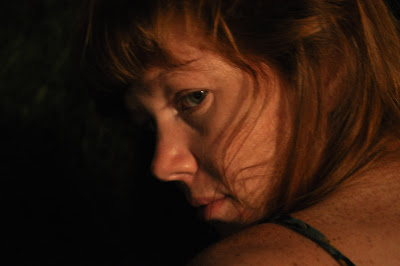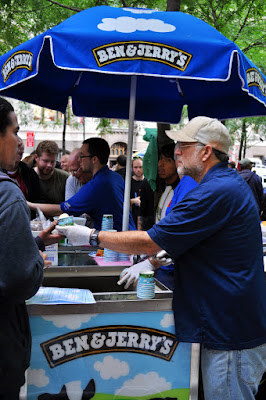
Looking in on a gallery opening at the Vermont Studio Center on a cold winter's night.
When I am feeling daunted by the uncertain road ahead to “artistdom,” I often look to artists I admire and am reassured by the stories of how they were able to make it work. Clare would question my logic in this. Clare, who is quoted in her sister Noreen Malone's Atlantic article, ‘The Kids Are Actually Sort of Alright,’ has some IM insight that begs a closer look:
CLARE: ok, you know what i always think about when i think of our generation? i read the david brooks book, “the social animal” and while it was only mediocre, he had this one really great bit that really stuck with me—the Greek ideal of “thumos”, which is the lust not for money or success (in the conventional sense) but the lust for glory
we want glory through our ideas-we want to know we matter
(10:33) the cold truth is that not all of us are brilliant
we are not all big thinkers. Not everyone’s TED talks will change the world
some of us will just dissipate into the ether
(10:34) but it is the digital connectivity, that proximity to these people, that makes us think that perhaps we will succeed as well
We might not be able to get our hands on everything we dream up, but we can get our eyes on it (Romeo-style). Our idols and their creations are more accessible than ever. So what I want to know is, with our all-access passes to stellar minds and their accomplishments, are we any closer to achieving personal greatness in our own fields or do the examples just serve to taunt and tease?
I do think that the insights that we are privy to via social media can be useful in giving us a leg up in terms of technical know-how and career advice. Its advantages are clear if you think about the opposite extreme. Imagine trying to become a painter in the renaissance if you weren’t accepted into a guild. You wouldn’t have access to training, travel, mentorship or materials. Apprentices of master painters would have all the resources and you would be out of luck. Whereas, in this day and age, you can teach yourself just about anything you can type into YouTube.
In this way, the playing field is somewhat leveled. But are more people going to do something inventive with the surplus of resources? Or is the internet chatter just going to cancel itself out -- a bunch of white noise -- with the usual small percentage of unique voices standing out above the rest?
Sometimes it’s painful to read firsthand accounts of startups and starlets and artists who have hit the big time. We don’t just know them from their rare public appearances anymore. We get to read their daily thoughts, become familiar with their shorthand and receive messages from them on our personal phones. The illusion is that this brings us closer. But the major-league baseball player that my friend follows on twitter is not invested in her. (Sorry girl! He’s just not that into you.) There’s no reciprocation.
Tantalus wanted in with the gods. His father was Zeus, so he was above your average mortal stock and got a dinner invitation to Mt. Olympus one day. In order to impress them, Tantalus sacrificed his son and served pieces of him as the main course. When the Gods found out what he’d done, they were repulsed and banished him to the special part of Hades reserved for really bad guys. He was forced to stand in a pool of water underneath a fruit tree and for all eternity be tantalized by their proximity. Whenever he reached for a fruit it would move just out of his grasp and when he bent down to drink, the water would drain.
I realize this is a downer metaphor for reaching for the stars, but I found it useful in fleshing out Clare’s observation. Personally, I am optimistic that our proximity to great things will wet our palates (and palettes), spark some healthy competition and connect us with other people thinking similarly. For instance, I have developed the (hopefully not too annoying) habit of writing people whose work inspires me and thanking them for making awesome things. It is pretty easy to find email addresses and many of them write me back and are supportive of my work. This doesn’t mean that they impart any special success potion, but I do find it affirming and energizing.

A failed video project in which an apple did not spectacularly explode. (Don Hershey and Erin Fitzpatrick at VSC)
Most of the people that I hang out with are involved in some form of art, music or writing. Even though they are from all over and have very different backgrounds, they do have a certain type of ambition in common. As Clare writes, they’re not after nice things or being famous for the sake of being famous. But I think it’s safe to say that they’d all like to make something kickass and have people know it and benefit from it. They want time to spend producing and time to spend enjoying the things that their friends produce.
My friend Erin Fitzpatrick from the Vermont Studio Center has been doing an interview project that might shed more light on the subject. It’s still in the beginning stages, but stay tuned on Fitzbomb.com to hear about how creative people have responded to her polarizing question, “Do you want to be famous?"

Teaser image of an upcoming video project about rituals.
 Winter Solstice at my grandmother's house in Houston.
Winter Solstice at my grandmother's house in Houston. My cousin Mira -- belly dancer, painter, costume designer and body painter. She has a new project called Sirens where she transforms women with fabric, feathers and paint into their particular type of goddess. I drove to visit her on Friday southwest of Austin in a small town called Driftwood. I passed Enchanting Oaks Drive and Crystal Hills Drive. After a wooden sign proclaiming "Wizard Academy," I took a right turn onto her dirt driveway. Her studio sprawled across the ranch-style house with headdresses and Indian garb adorning every surface. A cushioned construction in the living room was shaping up into a hookah lounge. Three feline sentinels took turns keeping watch and bossing around her large dog.
My cousin Mira -- belly dancer, painter, costume designer and body painter. She has a new project called Sirens where she transforms women with fabric, feathers and paint into their particular type of goddess. I drove to visit her on Friday southwest of Austin in a small town called Driftwood. I passed Enchanting Oaks Drive and Crystal Hills Drive. After a wooden sign proclaiming "Wizard Academy," I took a right turn onto her dirt driveway. Her studio sprawled across the ranch-style house with headdresses and Indian garb adorning every surface. A cushioned construction in the living room was shaping up into a hookah lounge. Three feline sentinels took turns keeping watch and bossing around her large dog.

























































